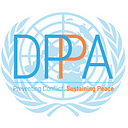Youth Explore the Future of Peacebuilding in Northeast Asia
Through DPPA’s “Futuring Peace” initiative, young people are finding new ways to share their vision of a peaceful northeast Asian region.
As is the case in much of the world, in Northeast Asia young people have traditionally had few, if any, opportunities to contribute to substantive policy discussions. Khishigjargal (Khishi) Enkhbayar, from Mongolia, is working with fellow young peacebuilders from across the region to change that. In 2022, Khishi was one of over 40 participants in DPPA’s “Futuring Peace in Northeast Asia” project.

Participants from China, Japan, Mongolia, and the Republic of Korea used strategic foresight tools to explore pathways to a peaceful future for the region. They examined a set of future scenarios with a horizon of 2040 and imagined how education, new technologies and innovative approaches could be used to build new regional narratives for Northeast Asia, a region that lacks common security structures and is often characterized by historical disputes and mistrust.
“Through the project we were able to break stereotypes that ‘young people are not ready’ or ‘don’t have enough experience’,” said Khishi. “We produced sound policy recommendations that have been shaped and molded through intergenerational dialogues.”
Those recommendations are collected in the policy report, “Future of Regional Narrative Building in Northeast Asia — Policy Recipes by Youth Peacebuilders”, of which Khishi is one of the lead authors.
In conversation with Politically Speaking, Khishi said, “I was simply blown away by the creative ideas that our region’s youth have come up with throughout the project”.
“The Youth Parliament for Climate Action, for example, is an actionable idea that could potentially have significant impact on youth leadership in the region,” she said. “Young people are eager to learn and eager to contribute, so facilitating spaces for capacity building, discussion, and action are crucial to meaningful youth participation in the region and beyond. It has the potential to elevate young people’s voices, shape regional narratives and empower young people.”

The report also calls for increased support to regional cultural and educational exchanges and the development of digital literacy programs for all ages, as well as increased private sector mobilization towards supporting regional youth exchange and bottom-up initiatives.
Khishi remains optimistic about the future, explaining that young people can overcome various challenges from the past and take the lead in constructing new regional narratives. “What could emerge is a Northeast Asia that invests and empowers their youth as well as takes advantage of technological advancements to collectively create an inclusive, green, and peaceful region” she said.

At home in Mongolia, Khishi has already put what she has learned about strategic foresight to use to design and conduct a National Youth Dialogue on Green Futures for more than 100 Mongolian youth.
+++
